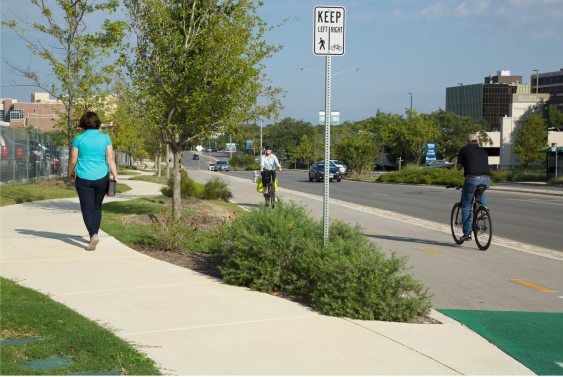 The 2007 launch of the T-Third Muni Metro line along the eastern waterfront coincided with a development boom. Flickr photo: Schaffner
The 2007 launch of the T-Third Muni Metro line along the eastern waterfront coincided with a development boom. Flickr photo: SchaffnerAn eye-opening report recently released by AARP , Reconnecting America and the National Housing Trust identifies the Bay Area as a national leader in placing affordable housing near high-frequency transit, but also points out that tens of thousands of subsidized units are at risk of being lost in the next five years.
The study, titled "Affordable Housing in Transit-Oriented Development" (PDF), found that 89 percent of the Bay Area's 26,710 privately owned but federally assisted housing units are located within a quarter mile of rail stations or frequent bus service, and that the contracts on three-quarters of those transit-accessible units will expire by 2014. Since high-quality transit has become increasingly attractive to wealthier individuals, the study speculates that some landlords may opt out of federal programs when their contracts expire, freeing them up to rent units at much higher rates.
Unlike public housing, federally assisted units are privately owned, and the federal government pays landlords the difference between what a tenant can reasonably pay based on their salary and the asking rent for a given unit, through programs like Section 8, Section 202, and Section 811. These units tend to be especially important to low-income seniors: nearly 56 percent of privately owned, subsidized residences are occupied by people 55 or older. Of people 75 or older receiving Federal Housing Assistance, 27.7 percent lived in privately owned, subsidized housing.
 Click to enlarge: Bay Area federally assisted, privately owned housing and transit access. Graphic from "Affordable Housing in Transit-Oriented Development".
Click to enlarge: Bay Area federally assisted, privately owned housing and transit access. Graphic from "Affordable Housing in Transit-Oriented Development".Transit access is especially important to low-income seniors, and for now, the Bay Area is succeeding in providing transit to seniors living in federally assisted housing. With the T-Third Muni light rail line spurring a development boom along the central waterfront, where a high concentration of subsidized units are located, many low-income tenants were at risk of losing transit-accessible housing until the financial meltdown slowed development. Those units could be at risk again when the economy recovers.
The problem is a familiar one for advocates of livable communities: good transit service is an immensely valuable asset for residents of any neighborhood, but it also has the potential to raise property values, and eventually force low-income and lower-mobility residents out.
"That is the conundrum. As you make a neighborhood more livable, you decrease the affordable units in the neighborhood, because you increase the value," said Marcy Adelman, founder of openhouse, which works to provide housing and services for LGBT seniors.
Gentrification pressures aside, Adelman said expanding quality transit service is essential for low-income seniors. "The closer that people with disabilities, or seniors, or all people are to transit, then the more independent they are, the more able they are to get around and get to doctors appointments, or go to work, or do the things they need to do."
 Expiring units within a half mile of quality transit as a percentage of total assisted units.
Expiring units within a half mile of quality transit as a percentage of total assisted units.Christina Olague, Vice President of the City Planning Commission and part of San Francisco Senior Action Network's Senior Housing Action Collaborative program, said she's also concerned about the issues the study identifies. "Much of the new housing under construction in transit corridors remains inaccessible to low income and fixed income individuals," said Olague.
She's worried that if seniors are forced out, they may be left with no good alternative. "As affordable housing options are limited in San Francisco, many seniors and persons living with disabilities are forced into Single Room Occupancy hotels," said Olague.
The study recommends increasing the federal funding available for assisted housing to keep up with higher asking rents. It also suggests implementing an early-warning system that gives tenants and housing officials advanced notice when a contract is set to expire soon.
While assisted housing units are mostly located near transit in the Bay Area, the affordable housing crisis is ultimately even more serious here than in most of the country, and losing well-placed units would be an especially damaging setback. Though affordable housing advocates are deeply skeptical of luxury-priced transit-oriented development, there is broad support for increasing transit access and livability across the city. For advocates of livable communities, the findings of the study underscore the importance of constructing buildings that are mixed-income as well as mixed-use.





